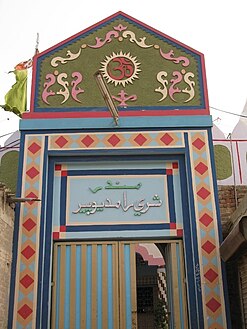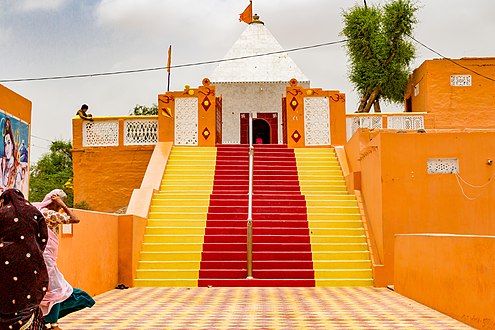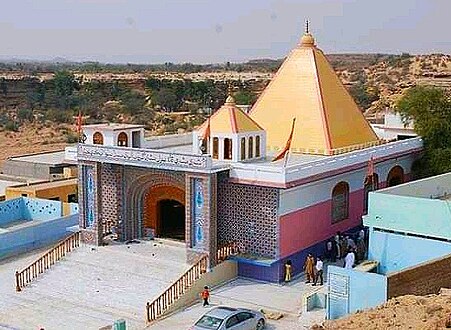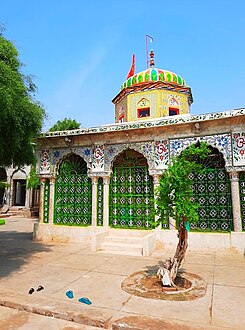Hinduism in Sindh
 Devotee at Karachi's Panchmukhi Hanuman Temple | |
| Total population | |
|---|---|
| Scriptures | |
| Bhagavad Gita, Vedas | |
| Languages | |
| Sanskrit (sacred) Sindhi, Dhatki (majority) Urdu and other languages (minority) |
Hinduism is the second-largest religion in Sindh, numbering 4.9 million people and comprising 8.8 percent of the province's population in the 2023 Pakistani census. Sindh has the largest population and the highest percentage of Hindus in Pakistan.[1] Sindh has the Shri Ramapir Temple, whose annual festival is the country's second-largest Hindu festival[2] (after the Hinglaj Yatra).[3]
History
[edit]The region and its rulers play an important role in the Hindu epic, Mahabharata.[4][5] Hinduism and Buddhism were the predominant religions in Sindh before the arrival of Islam,[6] when a number of Hindu castes and communities occupied the region. Many ancient Hindu temples still exist; many Hindu dynasties,[7] including the Gupta, Pala, Kushan and Hindu Shahis, ruled the region before Muhammad ibn Qasim led the Umayyad army in the Islamic conquest of Sindh.[8] The region still had a Hindu majority, but repeated campaigns and persecution by the Delhi Sultanate led to a gradual decrease in the Hindu population and an increased number of Muslims. Hindus were a minority in the region at the time of the Mughal Empire.[9] After the formation of Pakistan, most Hindus migrated to India.[6]
Demographics
[edit]Colonial era
[edit]| District or Princely State | 1872[10] | 1881[11] | 1891[12] | 1901[13] | 1911[14] | 1921[15] | 1931[16] | 1941[17] | ||||||||
|---|---|---|---|---|---|---|---|---|---|---|---|---|---|---|---|---|
| Pop. | % | Pop. | % | Pop. | % | Pop. | % | Pop. | % | Pop. | % | Pop. | % | Pop. | % | |
| Hyderabad District | 163,222 | 22.61% | 159,515 | 21.14% | 204,785 | 22.29% | 242,692 | 24.54% | 246,008 | 23.72% | 160,211 | 27.94% | 198,684 | 29.97% | 245,849 | 32.4% |
| Shikarpur District/ Sukkur District[a] |
147,224 | 18.97% | 167,896 | 19.68% | 185,813 | 20.3% | 218,829 | 21.49% | 155,156 | 27.03% | 148,188 | 29.04% | 177,467 | 28.45% | 195,458 | 28.22% |
| Tharparkar District | 84,112 | 46.53% | 93,094 | 45.78% | 132,468 | 44.42% | 151,726 | 41.7% | 196,793 | 43.08% | 176,026 | 44.41% | 218,850 | 46.76% | 247,496 | 42.6% |
| Karachi District | 72,513 | 17.12% | 82,860 | 17.31% | 103,589 | 18.34% | 115,240 | 18.96% | 111,748 | 21.42% | 138,485 | 25.55% | 162,111 | 24.93% | 222,597 | 31.18% |
| Upper Sind Frontier District | 8,777 | 9.75% | 14,756 | 11.88% | 18,816 | 10.78% | 22,765 | 9.81% | 26,495 | 10.07% | 23,855 | 9.91% | 29,174 | 10% | 28,664 | 9.43% |
| Khairpur State | — | — | 26,727 | 20.69% | 28,900 | 21.9% | 36,431 | 18.28% | 39,426 | 17.62% | 35,362 | 18.31% | 39,894 | 17.56% | 49,604 | 16.22% |
| Larkana District | — | — | — | — | — | — | — | — | 101,687 | 15.39% | 97,154 | 16.25% | 113,040 | 16.29% | 91,062 | 17.81% |
| Nawabshah District | — | — | — | — | — | — | — | — | — | — | 97,348 | 23.25% | 115,899 | 23.34% | 140,428 | 24.04% |
| Dadu District | — | — | — | — | — | — | — | — | — | — | — | — | — | — | 58,372 | 14.99% |
| Total Hindus | 475,848 | 21.7% | 544,848 | 21.43% | 674,371 | 22.45% | 787,683 | 23.1% | 877,313 | 23.47% | 876,629 | 25.24% | 1,055,119 | 25.65% | 1,279,530 | 26.43% |
| Total Population | 2,192,415 | 100% | 2,542,976 | 100% | 3,003,711 | 100% | 3,410,223 | 100% | 3,737,223 | 100% | 3,472,508 | 100% | 4,114,253 | 100% | 4,840,795 | 100% |
Modern era
[edit]In the 2023 census, Sindh's 4.9 million Hindus were 8.8 percent of the province's population; this included 1,325,559 (2.38 percent) scheduled-caste Hindus.[1] However, the proportion of scheduled caste Hindus is actually higher as they categorize themselves as Hindus in the census rather than as Scheduled Caste Hindu.[18] According to the Election Commission of Pakistan, voters who said that they were Hindu were 49 percent of the total in Umerkot and 46 percent in Tharparkar.[19][20] According to voter estimates, Hindus have a population of 50,000 or more in 11 districts. All are in Sindh, except for Punjab's Rahim Yar Khan District.[21]
Sindh also has Pakistan's highest percentage of Hindus overall, accounting for 8.8% of the population, roughly around 4.9 million people, and 13.3% of the province's rural population as per 2023 Pakistani census report. These numbers also include the scheduled caste population, which stands at 1.7% of the total in Sindh (or 3.1% in rural areas), and is believed to have been under-reported, with some community members instead counted under the main Hindu category. Although, Pakistan Hindu Council claimed that there are 6,842,526 Hindus living in Sindh Province covering around 14.29% of the region's population.
Umerkot District (52.15 percent), in Sindh, is Pakistan's only Hindu-majority district. The province's Tharparkar District has the highest district Hindu population. Four Sindh districts (Umerkot, Tharparkar, Mirpurkhas and Sanghar) account for more than half of the country's Hindu population.[22]
Hindu population by district
[edit]The percentage of Hindu population by district as per the 2023 census is shown below:[23]
| District | % |
|---|---|
| Umerkot | 54.66 |
| Tharparkar | 45.64 |
| Mirpurkhas | 41.48 |
| Tando Allahyar | 36.59 |
| Badin | 25.11 |
| Tando Muhammad Khan | 23.98 |
| Sanghar | 24.47 |
| Matiari | 18.03 |
| Hyderabad | 8.32 |
| Ghotki | 6.35 |
| Karachi South District | 4.24 |
| Jomshoro | 4.75 |
| Shaheed Benazirabad | 4.49 |
| Sukkur | 3.63 |
| Kashmore | 3.21 |
| Thatta | 2.92 |
| Sujawal | 2.65 |
| Khairpur | 2.9 |
| Jacobabad | 1.89 |
| Malir | 1.66 |
| Naushahro Feroze | 1.63 |
| Larkana | 1.44 |
| Shikarpur | 1.5 |
| Karachi East | 1.57 |
| Qambar Shahdadkot | 0.65 |
| Dadu | 0.64 |
| Keamari | 0.49 |
| Korangi | 0.44 |
| Nazimabad | 0.32 |
| Orangi | 0.29 |
Community life
[edit]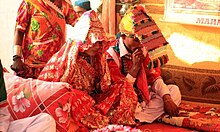
Many Hindus – especially in Sindh's rural areas – follow the teachings of 14th-century Ramdevji, whose main temple (Shri Ramdev Pir temple) is in Tando Allahyar. A growing number of urban Hindu youth in Pakistan associate themselves with ISKCON.[24] Other communities worship mother goddesses, their clan (or family) patrons.[25][26][27] Many Hindus in Sindh revere Guru Nanak, the founder of Sikhism, along with the Hindu gods. A large percentage of Sindhi Hindus consider themselves Nanakpanthi.[28]
Sindhi Hindus who cannot afford travel to India to release their loved ones' remains into the Ganges go to Churrio Jabal Durga Mata Temple in Nagarparkar.[29] According to a study, most scheduled-caste Hindus (91.5 percent) in the province's Tharparkar and Umerkot Districts faced discrimination and believed that its political parties are ignoring them.[30] Forced conversion of Hindu girls is a major problem faced by Hindus in Sindh, with an increased number of cases in the southern districts of Tharparkar, Umerkot and Mirpur Khas.[31] Sindh is Pakistan's only province with a separate law governing Hindu marriages.[32]
Ten seats are reserved for minorities in the provincial assembly.[33] In 2018, the Sindhi Krishna Kumari Kohli was the first Hindu to win a women's reserved seat in the Senate.[34] In the 2018 general election, Mahesh Kumar Malani (representing Tharparkar-II) was the first Hindu candidate to win a general seat in the National Assembly of Pakistan.[35] In the 2018 provincial assembly election, Hari Ram Kishori Lal and Giyan Chand Essrani were the first non-Muslims to win a general seat (non-reserved) in a provincial-assembly election.[36]
Temples
[edit]-
Ramapir Temple, Tando Allahyar, whose annual pilgrimage is Pakistan's second-largest Hindu pilgrimage
-
Umarkot Shiv Mandir, whose annual Shivrathri festival is one of the country's largest religious festivals[37]
-
Guru Balpuri Ashram in Thana Bulla Khan
See also
[edit]Notes
[edit]- ^ 1901: District headquarters shifted from Shikarpur to Sukkur, while district bifurcation created Larkana District.
References
[edit]Citations
[edit]- ^ a b "TABLE 9 : POPULATION BY SEX, RELIGION AND RURAL/URBAN, CENSUS - 2023" (PDF). Retrieved 30 May 2021.
- ^ "Hindu's converge at Ramapir Mela near Karachi seeking divine help for their security - The Times of India". The Times of India. Retrieved 30 May 2021.
- ^ "In a Muslim-majority country, a Hindu goddess lives on". Culture & History. 10 January 2019. Archived from the original on January 10, 2019. Retrieved 30 May 2021.
- ^ Gordon & Gordon 2014, p. 7.
- ^ Roy 2008l, p. 52.
- ^ a b Markovits, Claude (2000). The Global World of Indian Merchants, 1750–1947. Cambridge University Press. p. 278. ISBN 0-521-62285-9.
- ^ Abbasi 2014, pp. 102–106.
- ^ MacLean 1989, p. 16.
- ^ Kothari 2018j, pp. 78–93; MacLean 1989, pp. 34–35; TOI 2016, p. 1.
- ^ "Census of the Bombay Presidency, taken on the 21. February 1872". Bombay, 1875. 1872. p. 76. JSTOR saoa.crl.25057641. Retrieved 16 November 2024.
- ^ "Census of India, 1891. Operations and results in the Presidency of Bombay, including Sind". 1881. p. 3. JSTOR saoa.crl.25057678. Archived from the original on 1 June 2024. Retrieved 16 November 2024.
- ^ India Census Commissioner (1891). "Census of India, 1891. Vol. VIII, Bombay and its feudatories. Part II, Imperial tables". JSTOR saoa.crl.25352815. Retrieved 16 November 2024.
- ^ India Census Commissioner (1901). "Census of India 1901. Vols. 9-11, Bombay". JSTOR saoa.crl.25366895. Retrieved 12 May 2024.
- ^ India Census Commissioner (1911). "Census of India 1911. Vol. 7, Bombay. Pt. 2, Imperial tables". JSTOR saoa.crl.25393770. Retrieved 12 May 2024.
- ^ India Census Commissioner (1921). "Census of India 1921. Vol. 8, Bombay Presidency. Pt. 2, Tables : imperial and provincial". JSTOR saoa.crl.25394131. Retrieved 6 May 2024.
- ^ India Census Commissioner (1931). "Census of India 1931. Vol. 8, Bombay. Pt. 2, Statistical tables". JSTOR saoa.crl.25797128. Retrieved 5 May 2024.
- ^ India Census Commissioner (1941). "Census of India, 1941. Vol. 12, Sind". JSTOR saoa.crl.28215545. Archived from the original on 29 January 2023. Retrieved 5 May 2024.
- ^ "Scheduled castes have a separate box for them, but only if anybody knew". Retrieved 30 May 2021.
- ^ Khan, Iftikhar A. (28 May 2018), "Number of non-Muslim voters in Pakistan shows rise of over 30pc", Dawn, retrieved 30 May 2021
- ^ "Pakistan General Election: Non-Muslim voters increase by 30 percent in 5 years, Hindus most numerically significant minority", Firstpost, 22 July 2018
- ^ Aqeel, Asif (1 July 2018), "Problems with the electoral representation of non-Muslims", Herald (Pakistan), retrieved 30 May 2021
- ^ "District wise census". Retrieved 5 August 2021.
- ^ "7th Population and Housing Census". www.pbs.gov.pk. Retrieved 2024-07-21.
- ^ Latief, Samiya (July 18, 2020). "Explained: Pakistan's Krishna Temple and the controversy over its construction". The Times of India. Retrieved 6 June 2021.
- ^ Avari 2013, pp. 219–220
- ^ Abbasi, Muhammad Yusuf (1992). Pakistani Culture. Oxford University: HarperCollins. pp. 16. ISBN 9-789-694-15023-9. OCLC 218233296.
- ^ Ispahani 2017, pp. 56–61
- ^ Guriro, Amar (18 October 2016), "Struggling to revive Gurmukhi", Daily Times (Pakistan)
- ^ Iqbal, Aisha; Bajeer, Sajid (10 March 2011), "Contractor blasting through Tharparkar temple in search of granite", The Express Tribune, retrieved 30 May 2021
- ^ Shah, Zulfiqar (December 2007), Information on Caste Based Discrimination in South Asia, Long Behind Schedule, a Study on the Plight of Scheduled Caste Hindus in Pakistan (PDF), Indian Institute of Dalit Studies (IIDS) and International Dalit Solidarity Network (IDSN), retrieved 30 May 2021
- ^ Quratulain, Fatima (19 September 2017), "Forced conversions of Pakistani Hindu girls", Daily Times (Pakistan), retrieved 30 May 2021
- ^ Shahid Jatoi (8 June 2017). "Sindh Hindu Marriage Act—relief or restraint?". Express Tribune. Retrieved 30 May 2021.
- ^ Aqeel, Asif (1 July 2018), "Problems with the electoral representation of non-Muslims", Herald (Pakistan), retrieved 30 May 2021
- ^ "Hindu woman elected to Pakistan's senate in historic first: Report", Times of India, 4 March 2018, retrieved 30 May 2021
- ^ Fazili, Sana (29 July 2018), "Meet Pakistan's First Hindu Candidate Mahesh Kumar Malani to Win on General Seat", Network18 Group
- ^ "Pakistan election: Muslim-majority areas elect 3 Hindu candidates in Sindh". Business Standard India. 31 July 2018.
- ^ "The Shiva festival in Umarkot is a reminder of Sindh's Hindu heritage". 27 February 2018.
Bibliography
[edit]- Avari, Burjor (2013). Islamic Civilization in South Asia: A history of Muslim power and presence in the Indian subcontinent. Routledge. ISBN 978-0-415-58061-8.
- Ispahani, Farahnaz (2017) [2015]. Purifying the Land of the Pure: Pakistan's Religious Minorities. HarperCollins. ISBN 978-0-190-62165-0. OCLC 1020480157.
- MacLean, Derryl N. (1989). Religion and Society in Arab Sind. BRILL. ISBN 978-90-04-08551-0.
- Kothari, Rita (2018j). Unbordered Memories: Sindhi Stories of Partition. India: Penguin Random House. ISBN 978-93-5305-345-1.
- Bhavnani, Nandita (2014). The Making of Exile: Sindhi Hindus and the Partition of India. Tranquebar Press. ISBN 978-93-84030-33-9.
- Abbasi, Reema (2014). Historic Temples in Pakistan: A Call to Conscience. Niyogi Books. ISBN 978-93-83098-49-1.
- Gordon, A. D. D.; Gordon, Sandy (2014). India's Rise as an Asian Power: Nation, Neighborhood, and Region. Georgetown University Press. ISBN 978-1-62616-074-3.
- Roy, Kumkum (2008l). Historical Dictionary of Ancient India. Scarecrow Press. ISBN 978-1-4616-5917-4.
External links
[edit]- "History of Hinduism in Sindh from ancient times". The Times of India. 13 March 2019.

